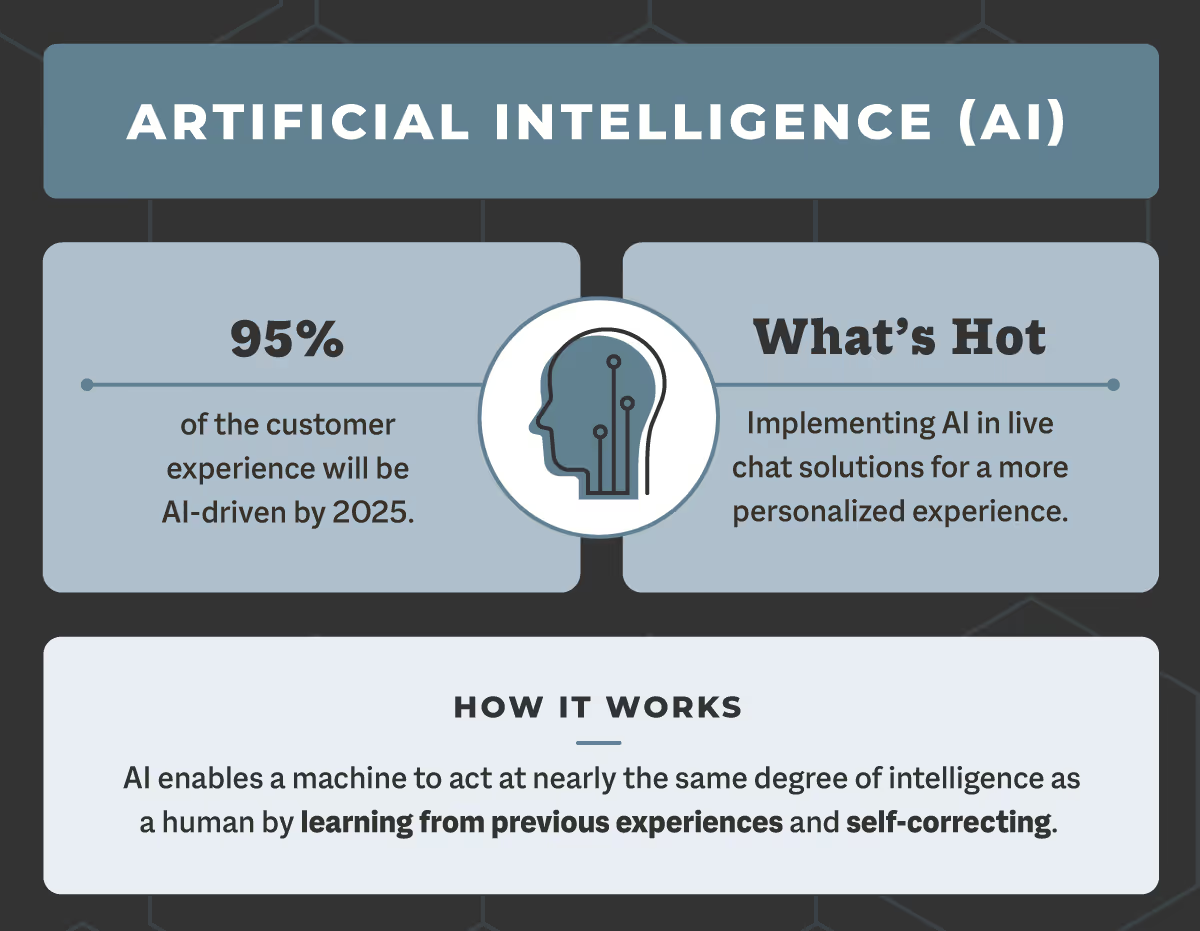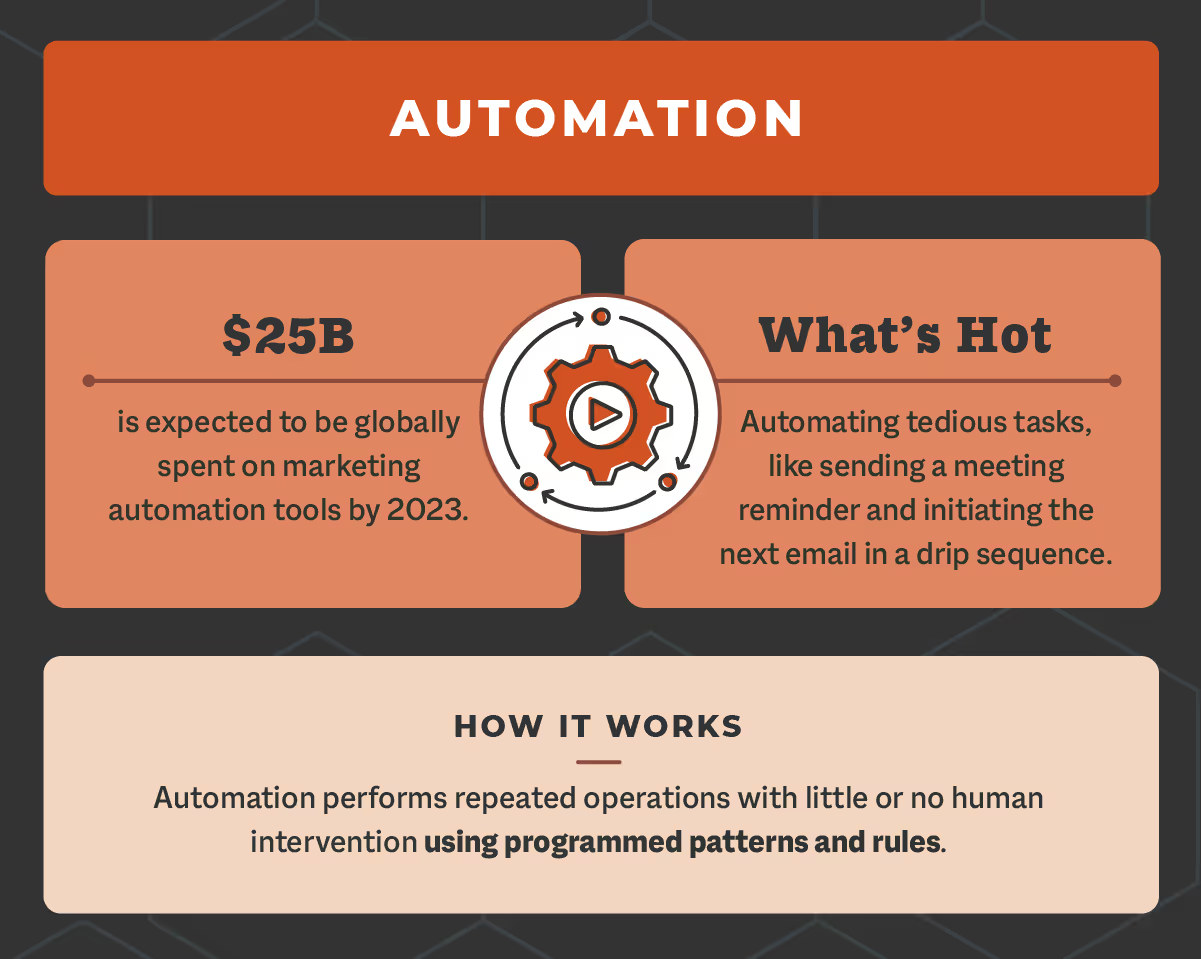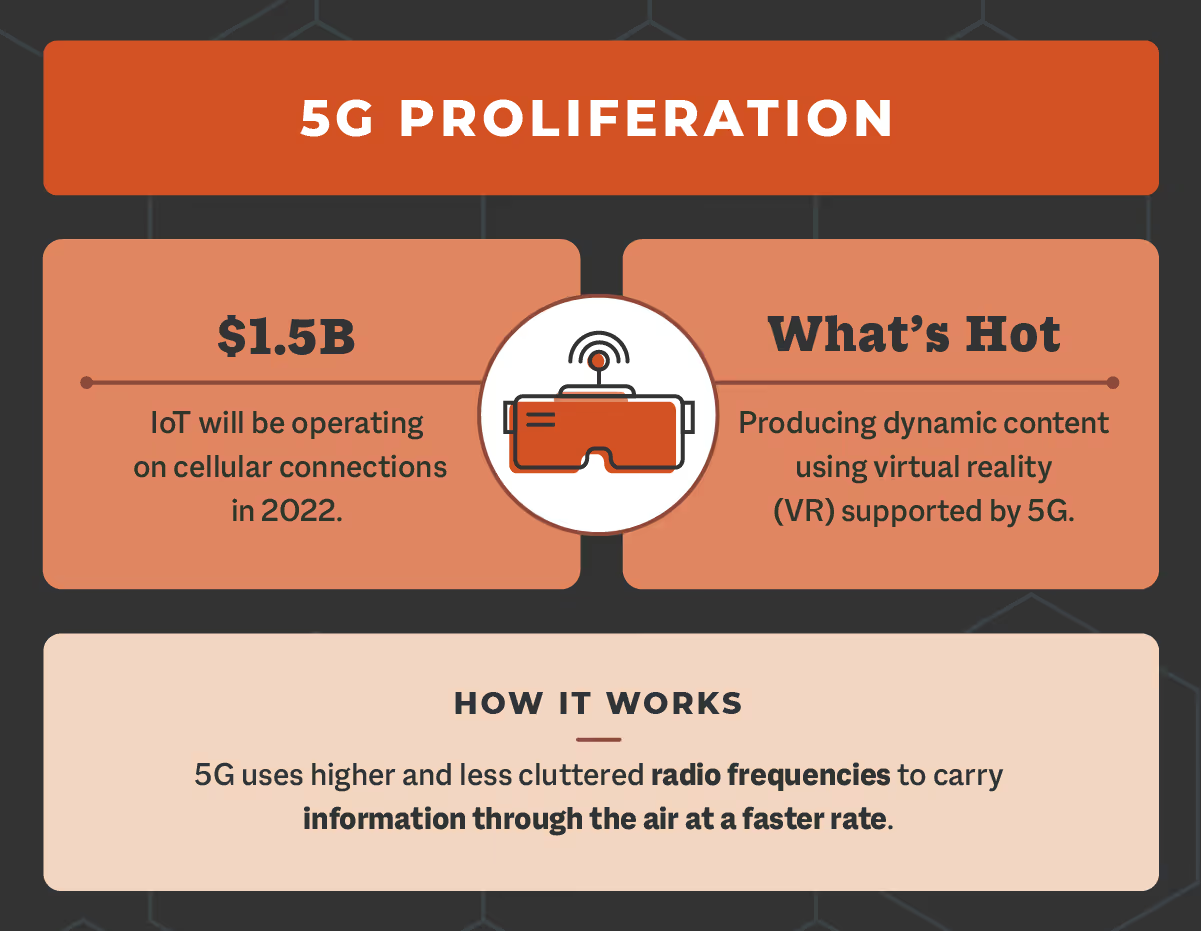12 Tech Trends That Will Change the Future of Small Business
12 Tech Trends That Will Change the Future of Small Business

Just over a decade ago, cloud computing and smartphones were only a few years old. Today, most of us, especially business owners who rely on these technologies to keep their businesses functioning, can't picture living without them.
Despite the fact that there are numerous small business tech trends that might help transform the small business landscape, 80% of small firms in the United States aren't fully utilizing these digital tools at their disposal.
Owners of small businesses are typically hesitant to adopt new technology for a variety of reasons, including perceived cost barriers, a lack of understanding, or the belief that digital tools such as social media or live chat are irrelevant to their industry.
These assumptions, however, are far from the truth. Due to COVID-19, there’s been a rise of various technologies causing many changes in small enterprises and consumer expectations alike. For many businesses, adopting new technology was the only way to keep up with the fast-paced environment during the pandemic.
Now that people are accustomed to these changes, some things might never return to how they were before the pandemic. While organizations around the world continue to adapt their operations, check out some of these small business technology trends to keep an eye on or skip to our infographic below.
1. Artificial intelligence
Artificial intelligence (AI) and machine learning has been a trending topic for years. If you don’t already know, AI enables a machine to act at the same degree of intelligence as a human by learning from previous experiences and self-correcting so it can make decisions, solve problems, and improve customer experiences.
AI offers huge advantages for small businesses, such as helping personalize interactions with customers. For example, Smith.ai’s live chat software uses artificial intelligence to learn what’s effective and refines accordingly, helping live agents work quickly and accurately to deliver personalized customer care.
This business tech trend is expected to grow in popularity, as artificial intelligence is predicted to drive 95% of the customer experience by 2025. Business leaders who implement AI technology early will profit from being ahead of the curve, since these breakthroughs will only become more important in the future.

2. Social media and influencer marketing
Digital marketing budgets are expected to increase by 25% on average across industries. Businesses are discovering that finding innovative strategies to break through the digital noise and keep their brands relevant is more crucial than ever. Given the present social media landscape, there are plenty of opportunities to reach your clients and customers.
Many businesses are already on social media, but a great strategy for small to midsize businesses is to leverage influencer marketing. Rather than utilizing cost-per-click (CPC) or your own company profiles, you can have influencers with a following of your target audience to promote your brand.
Influencer recommendations on social media assist 49% of customers in making purchasing decisions, and roughly 80% of consumers have purchased something after seeing it suggested by an influencer.
3. Automation
Automation is a system that performs repeated operations with little or no human intervention using pre-programmed patterns and rules. For example, if you ever book an appointment and receive a confirmation email or SMS message, this is an automated response.
Automation can help small businesses save time and money by automating tedious manual tasks such as inputting data into a system. A Salesforce study found that 55% of small businesses cite insufficient time as a substantial challenge. By incorporating automation into their system, employees can save time on manual processes so they can focus their efforts on doing work that drives profit.
Other examples include automating online pricing to balance profitability and revenue growth as well as inventory management systems to ensure the proper quantity of goods is on hand.
As of 2022, 68% of marketers use automation. It’s expected that a new generation of companies will be looking to develop these solutions for businesses to ensure that the demand for increasing automation continues. In fact, global spending on marketing automation tools is expected to surpass $25 billion by 2023.

4. Video communication technologies
In order to compete against enterprise-level competitors, small businesses usually rely on their personalized service models. However, decentralized operations and limited in-person interactions forced small businesses to adapt to stay relevant during the pandemic.
This started the demand for technological advancements to help improve engagement for both customers and employees. In 2020, virtual meetings to ensure face-to-face contact became popular, as well as hosting webinars in order to network and generate more leads.
Other apps, such as Loom, allow employees to record and share video messages of themselves, their screen, or both. Employees find this type of communication to be much more convenient than long emails or unnecessary meetings while adding a personal touch.
5. Increased cybersecurity
As more and more businesses move their operations and data online and on the cloud, cybersecurity has become increasingly important. While 60% of small business owners don’t think they’ll be the target of a cyber attack, 61% of small businesses have fallen victim at least once to a cybersecurity breach.
When your personal information and that of your clients is exposed, cyber attacks place your business in danger of financial losses and brand damage. Since these are crucial for the survival of businesses, the cyber insurance market is expected to grow to $14.8B in 2025.
Check out our post on the best password security apps for your small business so you can secure your data without spending a fortune.

6. Comprehensive HR technology
Organizations in various industries were forced to decentralize, adapt to the virtual workplace, and figure out how to effectively assist their employees in the face of quickly changing conditions.
With the shift to remote work, a demand for comprehensive human resources software and technology arose so that small business owners could keep track of their employees and their needs.
This has led to an increased need for online project management tools, payroll and remuneration for employees, workforce analytics, employee engagement platforms, and benefits administration.
7. Software integration and cloud adoption
Software integration is the process of combining multiple software systems into a single unified system. This allows you to input more data into your systems more quickly, reduce errors, and save money over manual processes.
If your business uses multiple applications, a software integration system will allow these different applications to communicate and work together to complete your goals. For instance, when you update a client’s contact information in one platform, you’ll want it to automatically update in other applications you are using to ensure consistency.
Small businesses will have a greater demand for software integration as they adopt new technology solutions. By 2026, it’s expected that 64% of business infrastructure will be fully on the cloud.

8. Remote onboarding tools
As more people choose remote employment and as more firms adopt this new model, remote onboarding processes will become increasingly reliant on technology. When it comes to employing new hires and familiarizing them with their roles and the company culture, onboarding is critical.
Starting a new job in a remote environment presents obstacles for employees, which employers should be aware of, because 64% of employees will leave a new company within the first year if they have a bad onboarding experience.
Businesses that use technologies to ensure that every stage of the onboarding process is meticulously planned and executed will be able to make their new team members feel valued and welcomed.
9. Live chat and conversational marketing
The B2B space will be dominated by chatbots and other conversational marketing activities in order to generate and nurture leads.
People want genuine human interaction that delivers immediate responses to their questions or pain points. In fact, 90% of customers expect an “immediate” (10 minutes or less) response to their support questions.
Nobody likes to send an email and then wait a week for a response from a salesperson. Businesses are looking into ways to make the sales funnel process seamless by incorporating live web chat, SMS, and social media messaging so they can deliver the quick gratification that people are looking for.
By 2025, the global market size for chatbots is expected to be around $1.25B.

10. Branded calling solutions
Marketers are aiming to build better personal connections with consumers in order to improve their relationships. A phone call is the best way to connect, as 92% of customer interactions are done via phone, yet most individuals don't answer calls from unfamiliar numbers. In fact, 94% of unknown calls go unanswered.
As spam calling continues to grow, small business owners find they are having a more difficult time reaching their customers and clients who work to block robocalls.
Branded calling allows a firm or organization to be easily identified on an incoming call screen. This can contain information such as the organization's name, logo, and reason for calling, enhancing the user experience while ensuring that essential calls are not missed.
For instance, First Orion retail clients have seen their answer rates increase by over 90% since implementing branded calling. By making it easy for customers and clients to recognise their brand, it increases the customer experience and overall perception of the company.
11. 5G proliferation
The fifth generation of cellular technology, 5G, provides significantly faster data transfer speeds than the more widely used 4G technology. This breakthrough is significant for the internet of things (IoT), as 5G networks are better equipped to handle the inflow of interconnected smart devices.
In 2022, there will be 18 billion IoT devices, with 1.5 billion of them operating on cellular connections. Many sectors are making large investments in augmented reality and virtual reality (VR), both of which will be supported by 5G.

12. Virtual reality (VR)
Virtual Reality (VR) is a computer-generated environment with realistic-looking images and objects that gives the viewer the feeling of being completely immersed in their surroundings.
VR technology can be used by B2B marketers to produce dynamic content that connects with the right buyer. VR is primarily beneficial as a visual storytelling tool since it can immerse the spectator in a totally immersive experience.
The following infographic featues all of the graphics in this blog post put together for easy reference.

Although some small businesses may not be at the cutting edge of technology development like enterprise-level companies, technology still plays an important part in their growth and efficiency. Those who are willing to adapt to new technology will see more income, more efficient operations, lower expenses, and faster growth.
If you want to start implementing newer, more efficient technologies but don't have the time due to high call volume or a flood of web chat inquiries, Smith.ai's virtual receptionists can help you deliver high-quality communications across channels so you can focus on determining which small business tech trend to tackle next.
Sources: Deloitte | Salesforce 1, 2 | HubSpot 1, 2, 3 | Forrester | Cision | Cybersecurity Magazine | Cybercrime Magazine | Oberlo 1, 2 | Bob | Daily Blogging | Hiya | OpenGrowth
Take the faster path to growth. Get Smith.ai today.
Key Areas to Explore
Technical Implementation Terms
Voice user interface (VUl) design
Speech recognition integration
Text-to-speech optimization
API connectivity and webhooks
Real-time data synchronization

Your submission has been received!














.svg)



